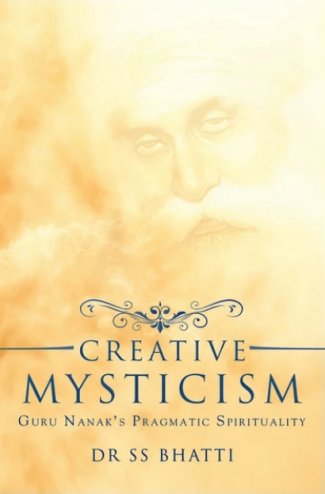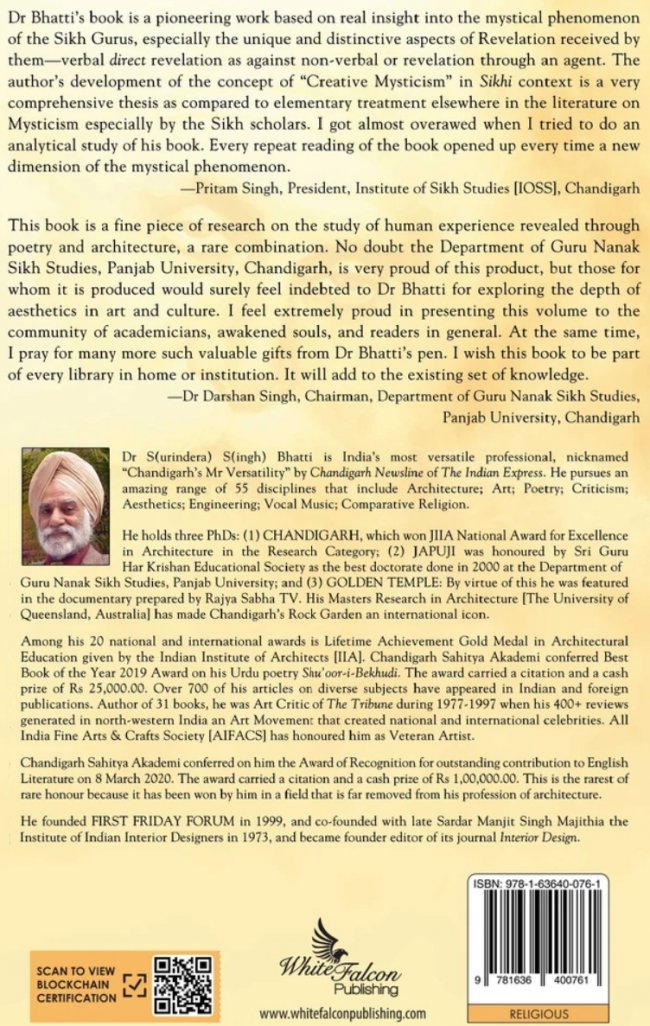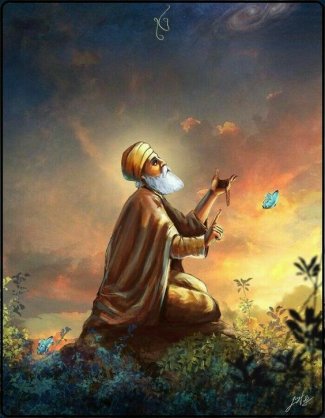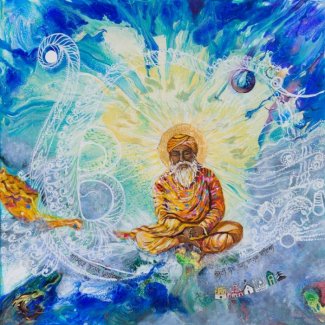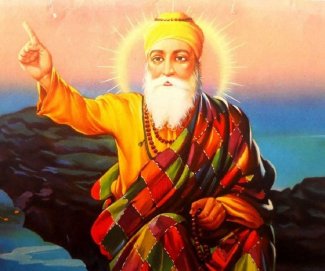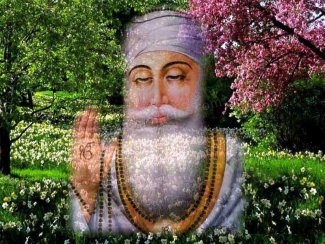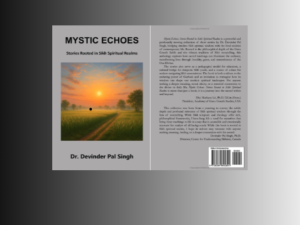Title of Book: CREATIVE MYSTICISM: Guru Nanak's Pragmatic Spirituality
Authored by: Dr. Surindera Singh Bhatti, Chandigarh
Published by: White Falcon Publishing, Chandigarh, 2020 (Paperback First Edition, Pages: 326; Price: Rs. 499, US:$20)
Reviewed by: Prof. Hardev Singh Virk, #14017, 30 Ave, Surrey, BC, Canada
While paying my tribute on Dr. Bhatti's 82nd birthday, I called him "Creativity Incarnated''. Perhaps, he is the only author, who can use metaphors of geometry, nuclear reactor, neutron and nucleus to explain Nam - Simrin: "Naam-Simrin is akin to bombardment of the nucleus with neutrons in that Naam is repeatedly aimed at the nucleus, the crucial centre of soul-consciousness (Surt), lodged within the cranium cavity”. During the 550th anniversary year of Guru Nanak, Dr Bhatti has published an anthology "GURU NANAK DEV ─ Dispenser of Love and Light" which has been reviewed by me. In the same series, he brings out his second volume based on his exploration of Guru Nanak's Pragmatic Spirituality, calling it "CREATIVE MYSTICISM", a term coined by him.
I was reluctant to review this volume as it was beyond my power of comprehension how to do justice with Guru Nanak's Creative Mysticism? I feel handicapped, as a Physicist dealing with material reality of the physical universe, to make inroads into the domain of Spirituality. I was overwhelmed after reading the Introduction, Foreword, Preface and Prologue of this book and felt exhausted to probe further the inner core of this treasure house of knowledge on an esoteric subject. The author's insistence to study it as a composite whole motivated me to undertake this onerous task.
In the Prologue, Dr Bhatti explains the Objectives, Scope and Methodology of this volume:
Objectives of this Study: Major objectives of this volume are to study/establish that:
1. Revelation is a valid means of (direct) knowing,
2. Religion is the Architecture of total human consciousness, integrating Soul, Mind, and Body in the individual as an active agent of Pragmatic Spirituality which he develops creatively through everyday work,
3. The Revealed Word (Gurbani) is enlarged and extended as Life evolves through a multi-dimensional historical process,
4. Deeds grounded in Dharma make a human being a fit and deserving person to receive God’s grace for his spiritual ascent,
5. Creative Mysticism, as propounded by Guru Nanak in Japuji, holisticises the Quintessence of Religious (i.e., non-dogmatic, forever progressional) Life, as, while exalting the mundane to the sublime during workaday existence, it impels the seeker-doer to be a creative, not merely a (re-)productive, person—thereby enabling him to acquire a view and way of life free from the arcane intricacies and disabling encumbrances of ritualistic, sectarian, communal, and doctrinaire propriety, and
6. Guru Nanak’s Bani is neither Mythology nor Metaphysics, nor the Muse, not even Mysticism or Creativity divorced from life. It is Revealed Word packaged in Creative Mysticism, A Universal-Timeless Formula—unprecedented in sacred literature—as easy to understand and apply, for humankind’s social amelioration, ethical purgation, aesthetic advancement, and spiritual salvation.
The author moves on to explain Creative Mysticism as his coinage:
“Mysticism is Experience (of the Divine), and creativity is its artistic Expression. One without the other is incomplete. Together they give birth to what I call: Pragmatic Spirituality. The Guru’s pre-eminent contribution lies in that, by virtue of his unprecedented Creativity, he brings his marvellous Mysticism to the doorstep of the common man—offered on a platter of Divine Grace, for which he thanks (and takes no credit whatsoever) His Monarch-Maker: Wah-e-Guru (Hail The Guru!). This is the sole reason for my insistence that Guru Nanak’s Bani is neither mythology, not Metaphysics, not even the Muse. It is Creative Mysticism: a God-oriented soul-consciousness (Surat), always in the ascendant (Charhdi kala), forever in Extroversive (Altruistic) Progression—a long stillness of prayer for Divine Grace built around an unbroken, joyous thanks-giving through life’s thick and thin, in an imperturbable acquiescence of all mortal longings''!
In the Chapter "Dhyan Sadhna", the author has revealed his expertise in the domain of Indian Religions and their dogmas. Under the heading "Meditation become Market", he is at his rhetoric best: "That someone goes to church regularly does not necessarily mean that he accepts God as God. He goes there as if the church were a Spiritual Mall in his Religion’s Downtown where he could get anything that he desires. Other peoples of the world going to their own Places of Worship—Mandir [temple], Masjid [mosque], Synagogue, Gurdwara [Sikh temple]—belong to the same category as the church-goer if they have not already accepted God as God. They go there to strike a deal that would be profitable to them in the long run. It is these people who have turned Places of Worship into Markets".
The author quotes Jiddu Krishnamurti to explain male and female principles: "Space is the Female Principle. Time is the Male Principle. According to Jiddu Krishnamurti, "Time creates its own Space". However, the author stresses the fact that "Space is more fundamental, for without Space nothing can exist. Even the densest matter has got inter-atomic Space. The unremitting dynamism of Life lies in that all events take place in Space through Time."
Before grappling with the main subject-line of his book, the author tries to set up the framework of his methodology in Chapters: Dhyan Sadhna, Nirman Marg, Creationism Versus Evolutionism, Heredity, Environment, Circumstance. I will not dilate upon the contents of these Chapters. The author denounces Yoga in no uncertain terms as follows: "If you want to learn how to tell genuine from fake in what is these days selling like hot cakes globally –YOGA and all that related humbug—I urge you to spare you valuable time to read the material in this Section". The author recounts how it took 50 years of his life to discover the Holistic nature of the World in the Chapter "Heredity, Environment, Circumstance".
I feel "Nirman Marga: The Creative Way" is the best chapter in this section. It reads as the author's journey to perfection and acquisition of knowledge in 51 disciplines in addition to those in which he had professional training. I believe this Chapter needs pruning and there is no need to be self-explanatory about one's achievements. Let the reader come to his own conclusions after reading this volume.
Before starting his odyssey with Guru Nanak, Dr Bhatti gives us an inkling of his own Creativity which he alludes to the grace (Nadar) of Guru Nanak: "My ever-widening and ever-deepening Creativity in diverse fields of human endeavour convinces me beyond all shadow of doubt that this unique prescription of Guru Nanak Dev has the self-renewing nuclear power of Pragmatic Spirituality that automatically jettisons the need for a human Guru. In the drunken stupor of having discovered Joyous Wonder [Vismaad] in versatile Creativity my sharpened awareness often negotiates, if only for a fleeting while, the elusive territory of Mysticism, from where mute suggestions echo to assure me that God is helping me to become a worthy receptacle of His grace. And thanks to Guru Nanak Dev’s infinite mercy and active concern for the amelioration of the human condition worldwide that I too will soon be a tiny, yet enormously fortunate, beneficiary of divine grace".
Chapter on GURU NANAK is based on hagiographic description of Guru's life but towards its end author gives the crux of Guru's message as follows: "A novel contribution of Guru Nanak Dev was the revolutionary declaration that renunciation is not all necessary for God-realisation. Much to the contrary, a householder’s path is the rich resource from which an earnest seeker ought to manifest life’s many-splendouredness. The discerning Guru promptly figured out that those desirous of God-realisation regarded the responsibilities of family life as something inferior and an obstacle in the way of their ill-conceived destination. This was entirely the result of wrong education by those self-styled Gurus [actually ‘con men’] who exploited the gullibility of the masses to do brisk business and to stay in position of social control. They propagated with thunderous success the silly notion that this world is a dark dungeon of pain and disillusionment in which whoever gets caught has no chance of liberation. They thus insisted that spiritual benediction required the performance of austerities and so-called meditation in splendid isolation. Guru Nanak Dev made bold to declare this centuries-old malaise as fundamentally wrong and morally corrupt. Guru Nanak’s Revelation offered to a chronically sick Indian society such psycho-spiritual exhortations as warranted ‘involvement’ in rather than ‘escape’ from workaday existence.
His prescription was:
To remain pure in an ambience of moral pollution is the right method of renunciation.
In the first Chapter "In Architect's Approach to Religion", I find a beautiful definition of Religion: "Religion has three major components: ritual, myth, and philosophy. Ritual (an incomprehensible code of religious ceremonies) is a specific, observable kind of behaviour based upon established or traditional rules. Known in all societies and dependent on belief systems, rituals may be viewed as symbolic acts based upon arbitrary rules similar to those of language. Myth and Mythology are two terms used in the study of religion and culture the subjects of which are accounts about Gods or superhuman beings and extraordinary events or circumstances in a time that is altogether different from ordinary human experience. Philosophy is an academic discipline that revolves round man’s endeavour to reflect deeply in a rational, methodical, and systematic way upon those aspects of experience that are of greatest concern to the human community. A vast majority of people mistake rituals for Religion because of their ignorance. The performance of rituals thus becomes a repetitive and mechanical affair, devoid of meaning that could enrich common man’s life. In its extreme meaningless form, Religion as rituals ends up being the “blind faith” of the literate masses".
Dr Bhatti is a master of exposition in his thesis to establish GURU NANAK as a UNIQUE Prophet who has no truck with the three disciplines of (1) Mythology, (2) Metaphysics, and (3) Poetry, to see how Guru Nanak’s Bani, with focus on Japuji, is none of these, either singly or in combination. It is quite simply an unpremeditated expression of the Divine Word that he received in his Revelation. Guru Nanak’s unremitting insistence on Sahj (i.e., unconditioned spontaneity) precludes the use of premeditation in all activities, including the creation of literary works. His mantra (the master-word) is meditation on the Holy Name—a hallowed creativity that subsumes all human activities by becoming the Soil of Pragmatic Spirituality. Such a state of mind, which Guru Nanak’s Creative Mysticism fashions, requires for its raw material only one unalterable quality: Humility.
Chapter II opens with the author's commentary: "Guru Nanak’s Bani is a paragon of Creative Mysticism, exhorting the common man to a life of Sachiar, as Pragmatic Spirituality, during workaday existence". Then he moves on to make a distinction between Creativity, Mysticism and Creative Mysticism: "Creativity, without a matching dose of Mysticism, can be highly self-indulgent in the pursuit of aesthetic pleasure which it gives. Creativity and Mysticism, in their stated forms of exclusionism, are frequently exploited by their practitioners to mislead the masses in pursuit of personal gains. Thus Creative Mysticism is a consciously-identified means, deliberately developed into a highly-skilled pursuit.......Creative Mysticism recognises and respects the interdependence and interrelationship between Creativity and Mysticism". The inter-relationship of these terms is made intelligible as follows:
Mysticism, as a seeker’s way of attaining direct intercourse with God in an elevated religious feeling or ecstasy, operates the mind at high-capacity.
Creativity, as a never-ending adventure into the realm of the human spirit, impels the mind to work at unusual-capacity.
In Creative Mysticism, the mind works, perforce i.e., by the necessity of its own awakening/activation, at near-full-capacity.
By his Creative Mysticism, Guru Nanak brings all knowledge (Gyan)—Book of Life, Book of Nature, Book of Wisdom (All Scriptures), and Book of Grace—within the immediate reach of the poorest of the poor—timelessly, and universally, thereby enlarging and extending the Revealed Word (Gurbani) as life evolves through a multi-dimensional historical process.
Author sums up his IDEAS in the highly sophisticated mode of expression: "In Guru Nanak’s Bani, Revelation makes his Mysticism a Timeless Experience, and his Creativity a Universal Expression for communicating God’s Word (shabad) for the general weal of all humankind (Sarbat da Bhala). In other words, Creative Mysticism, as enshrined in Guru Nanak’s Bani, holisticises the quintessence of Religious Life, and develops the seeker’s Spirituality pragmatically during workaday existence".
Chapter 6 sums up author's ideas on Guru Nanak’s Revelation which is an outstanding expression of Creative Mysticism, and it differs both in nature and significance from all other known forms of revelation both Eastern and Western:
(a) “A process whereby the religious seeker, actuating his deeper spiritual powers, escapes from the world of change and illusion and comes into contact with ultimate reality” (Hinduism).
(b) “The gracious self-manifestation of the divine to those who open themselves in loving contemplation” (Bhakti, or devotional theism).
(c) “An enlightenment gained through discipline and meditation” (Buddhism).
(d) “The transparency of the immanent divine principle or way” (Taoism).
(e) “The inspired words [of Moses and the Prophets who, as the chosen spokesmen, interpreted God’s Will and purposes to the nation] to be accepted in loving obedience as the Word of God” (Judaism).
(f) “As occurring primarily in the life, teaching, death, and Resurrection of Jesus, all interpreted by the apostolic witnesses under the illumination of the Holy Spirit” (Christianity).
(g) “A declaration of God’s Word rather than His personal self-disclosure” (Islam).
(h) “The difference between good [Truth] and evil [The Lie] and (thereby) to know the one true God” (Zoroastrianism).
Guru Nanak’s Revelation makes a radical departure from the teachings of other religion by unequivocally and unremittingly asserting the indispensability of good moral conduct as the launching ground for man’s take-off to a flight into the realm of the higher, deeper, better, and fuller life. Humility is a major touchstone in Guru Nanak’s Revelation. Guru Nanak illustrates the indispensability of Humility by his own example:
Neechan andar neech jaat neechie hoo att neech(u)
Nanak(u) tinkai sang-saath vadiya siyo kya rees
Jithai neech samaaliyan tithai nadir teri bakhsees
(Sri Guru Granth Sahib, p. 15)
Lowest among the low castes, lower than the lowliest
Nanak identifies with and dwells among them
Those with worldly greatness he envies not
Thy glance graces the place where the humble are cherished
Author has quoted verses from the Bani to establish his thesis that GURU NANAK's REVELATION is a unique phenomenon in the history of World religions. The author unequivocally refers to the injunction of Guru Nanak : "Lifelong involvement in socially-beneficent action, not escape from this-worldly reality, is the ultimate touchstone of Guru Nanak’s Revelation as manifest in his Creative Mysticism. Neither pious intentions nor erudite discourses would eventually avail in the pursuit of Truth. Thus, sewa—the most important tenet of Guru's Creative Mysticism—is, in reality, the pragmatic application of Humility to the unremitting challenges of workaday existence, which provoke one to be arrogant!" The author concludes this Chapter: "Guru Nanak’s Bani convincingly corroborates the plain truth that Revelation is a valid means of (direct) knowing—which is the result of divine tutelage that no university education can ever provide!"
The last two Chapters represent the application and assessment of the author's Thesis. The core of Sikh philosophy is reflected in the 26 Principles/Axioms/Aphorisms of Guru Nanak’s Creative Mysticism in Chapter 7. I had to take a plunge and delve deep into the author's mind to discover this goldmine of pragmatic Sikh spirituality. I want to end this review with another beautiful quote which shows the flight of Dr. Bhatti's mind imbued with the Creative Mysticism of Guru Nanak: "When the Humanities (all philosophies, social sciences, etc.) will have explained everything it could—yet not quite; when Art (dance, drama, music, literature, painting, sculpture, architecture, etc.) will have expressed everything it could—yet not quite; when Science will have explored everything it could—yet not quite; when Technology will have captured all the planets in the Solar System—yet given up in despair of surfeit; then and then alone would Humankind’s self-exhausted Ego turn to Guru Nanak’s Creative Mysticism for the panacea of its many incurable ills".
Author has given an exhaustive Bibliography to show the range of his study. But, I wonder why the author wants to load extra baggage on his flight to Guru Nanak's Creative Mysticism? I wish he prunes the text by one third by deleting some extra Chapters in the book which have no direct bearing on the topic under discussion. To my surprise, author has added an extra Review "Guru Nanak’s Revelation" at the end, which makes my effort almost redundant. In my view, this extra baggage dilutes the impact of his genius to create an architecture of Guru Nanak's Creative Mysticism.
There are 14 Sonnets of 14 lines each which establish the author's affinity with the poet-laureate, Shakespeare. Most of these Sonnets are relevant to the topics under discussion and, I must proclaim, surpass the inner beauty of Shakespeare's creation. I quote what MYSTICISM stands for in author's mind:
M-Y-S-T-I-C-I-S-M, to me, is deep Meditation
On Yin-yang principle in which the mind Sees
Truth in Its powers of Creation and Invention
In Splendorous Majesty carrying God’s decrees
Mysticism is the habit of religious thought ‘n’ feeling
Of those seeking direct communion with God in appealing
I feel humbled to review this volume as its beauty and relevance surpasses all that has been written about GURU NANAK during the last 551 years for the English speaking world. I have special reasons to feel elated as this volume will blast the arguments of all those Sikh and non-Sikh scholars to smithereens who are engaged to prove that Guru Nanak Bani is not original in its approach to Reality but a mere replica of Vedic lore and its Mysticism borrowed from the Sufi and Bhakti traditions of India.
The greatest contribution of Dr. Bhatti is to put Guru Nanak's Revelation on a high pedestal where faith and reason (Religion and Science) are compatible and juxtaposed.



